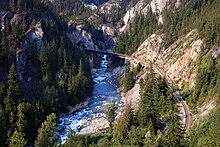Cheakamus River derailment


The Cheakamus River derailment occurred on August 5, 2005, when nine cars that were from a Canadian National Railway freight train derailed and crashed into the Cheakamus River in British Columbia. The cars contained approximately 40,000 litres of caustic soda (sodium hydroxide), which entered the river, killing more than 500,000 fish from 10 different species, including chinook salmon, coho salmon, pink salmon, and rainbow trout, both freshwater and ocean-dwelling.[1] Juvenile rainbow trout were the most affected at a mortality rate of 90% and it was also estimated that the adult chinook salmon mortality rate reached 50%.[2]
On November 5, 2005, federal transport minister, Jean Lapierre, ordered Canadian National to limit the number of cars of its conventional trains travelling in the area of the derailment between Squamish and Clinton to 80 cars, as a result of the derailment; the train involved had 144 cars. In 2007, an investigation report from the Transportation Safety Board of Canada revealed safety issues regarding operation of the train, such as not having the safest technology and improper training of the crew's response to the various safety alarms. Additionally, they reported that the track had no contributing factors to the accident.[2] It was revealed that the train was going uphill when nine cars fell from a bridge into the Cheakamus River.[3] Transport Canada limited horsepower and tonnage after the accident and CN faced federal and provincial charges.[4] In 2006, it was estimated that it would take approximately a decade for the river to completely recover from the derailment. Attempts at restoration began by trying to introduce 20,000 juvenile steelhead salmon that would have been hatchery raised from 40 wild adult steelhead salmon.[5] In 2010, CN Rail pleaded guilty to one federal charge under the Federal Fisheries Act and had to pay $350,000 towards conservation efforts and an additional $400,000 as a penalty for pleading guilty to the charge.[6]
The derailment cost CN at least $7 million.[3]

Sodium hydroxide effects in aquatic environments
Sodium hydroxide (NaOH) has the potential to be a dangerous chemical in aquatic environments due to it raising the pH level of the water. At low concentrations, NaOH will be neutralized by other chemicals in the water, such as acids and dissolved carbon dioxide (CO2). Also, NaOH does not bioaccumulate in the aquatic organisms as it is dissolved in the water and has a negative octanol-water partition coefficient.[7] The median lethal dose (LC50) concentrations for aquatic organisms for NaOH range between 33 and 189 mg/L.[8] The pH concentration can be defined as the concentration of free hydrogen ions in the water.[9] Extremely high pH levels will harm fish, specifically juveniles, by removing their slimy coats and drying out their skin, eyes and gills. Consequently, raising the pH of an aquatic environment can directly increase the toxicity of other chemicals, such as ammonia (NH3).[10] This is because at basic pH concentrations, NH3 becomes more prevalent than ammonium (NH+4), and it is dangerous to aquatic life. When pH levels increase above 9, NH3 concentrations are over 100 times higher than below pH of 9.[11] Ultimately, high pH concentrations can lead to death of organisms in aquatic environments and directly reduce biodiversity in these environments.[11] If not caused by man-made industries or accidents, high pH surges can occur naturally and may be observed when algal blooms occur, otherwise they are virtually impossible to observe without directly measuring the pH of the water.[11]
See also
References
- ^ "The Pacific Streamkeepers Federation - Cheakamus River Spill". www.pskf.ca. Retrieved 2022-12-05.
- ^ a b Government of Canada, Transportation Safety Board of Canada (2007-05-30). "Railway Investigation Report R05V0141 - Transportation Safety Board of Canada". tsb.gc.ca. Retrieved 2022-12-04.
- ^ a b Pollon, Christopher (2010-08-20). "Five years after disastrous B.C. spill, the Cheakamus River teems with life". The Globe and Mail. Retrieved 2022-12-04.
- ^ Sutherland, Scott (August 3, 2007). "CN Rail faces five charges in 2005 toxic spill in B.C.'s Cheakamus River". The Canadian Press. ProQuest 360038737. Retrieved December 4, 2022.
- ^ Meissner, Dirk (April 26, 2006). "Hatchery steelhead bound for B.C. river polluted by toxic CN Rail spill". The Canadian Press. ProQuest 359916177. Retrieved December 4, 2022.
- ^ "Province of British Columbia: B.C. Government Releases Compliance Summary". M2 PressWire. April 19, 2010. ProQuest 444705438. Retrieved December 4, 2022.
- ^ "Global Product Strategy (GPS) Safety Summary Caustic Soda" (PDF). October 18, 2013. Retrieved December 5, 2022.
- ^ "SIDS Initial Assessment Report For SIAM 14". Retrieved December 5, 2022.
- ^ "pH Scale | U.S. Geological Survey". www.usgs.gov. Retrieved 2022-12-06.
- ^ "Effects of acids and alkalis on aquatic life". www.lenntech.com. Retrieved 2022-12-06.
- ^ a b c US EPA, ORD (2015-11-04). "pH". www.epa.gov. Retrieved 2022-12-06.
